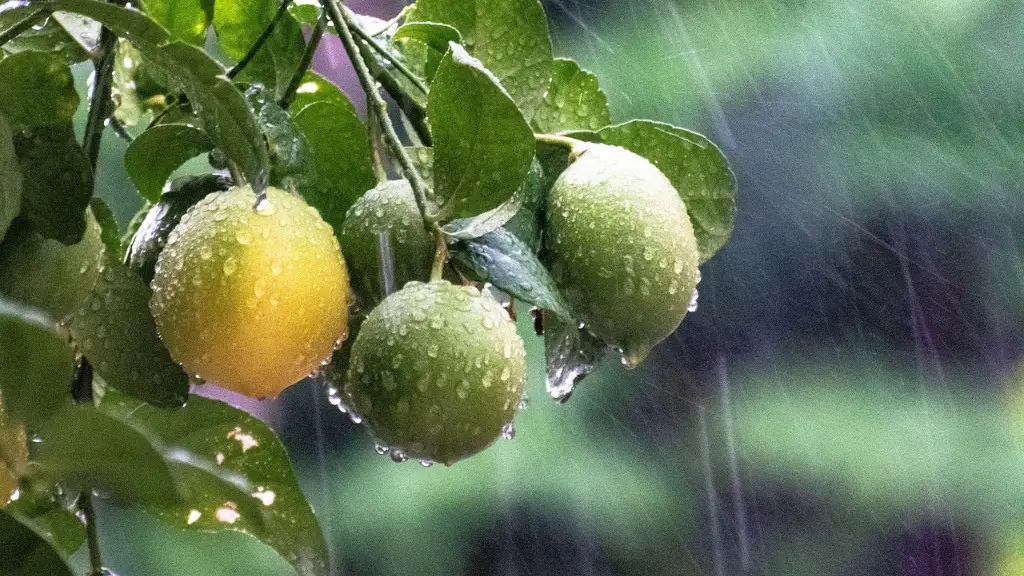Learning how long it takes to grow a lemon tree is an important task for any gardener or aspiring citrus enthusiast. Lemon trees are relatively easy to cultivate and can produce delicious, juicy lemons in a relatively short time. Lemon trees do well in many different climates, from temperate zones to warm, humid climates. In general, it takes about two years for a lemon tree to produce fruit and an average of three years for the tree to reach maturity.
The timing for a lemon tree to fruit and reach maturity depends on several factors. The type of tree, local climate, and care it receives all impact how long it takes for a lemon tree to reach fruit-bearing age. Young trees should be placed in a location that receives plenty of sunlight during the day and partial shade at night to ensure ideal growth conditions. If a lemon tree is planted in an appropriate climate with proper care, it will fruit in approximately two years.
In addition to climate and care, the frequency of fertilizing is another key factor in the lemon tree’s growth. Trees should be fertilized twice a year, generally in late spring and midsummer. Repeatedly fertilizing the tree with an appropriate plant fertilizer will ensure healthy, abundant growth, leading to a faster path to maturity.
Pruning is also essential to ensure a healthy, fruitful lemon tree. Pruning should be done in the springtime, after all danger of frost has passed but before new growth appears. Pruning stimulates healthy new growth, and it also promotes air circulation, allowing for more even ripening of the lemons. Pruning the tree also gives it a pleasing shape and prevents overcrowding of the branches which can significantly reduce the amount of lemons it can produce.
When taken care of properly and provided with the right conditions, a lemon tree can produce an average of three years after its planting. Taking into account certain environmental and maintenance factors, however, the time frame may vary. With the right conditions, however, the delicious fruit of a lemon tree can be harvested for years to come.
## Encouraging Growth
To get the best growth out of a lemon tree, there are several steps a gardener can take. Applying high-quality soil in the planting area and incorporating compost as top dressing are two important steps. The soil pH and amount of nitrogen, potassium and phosphorus should also be monitored and adjusted as necessary.
Regular waterings are also essential for a healthy tree. The quantity and frequency of waterings depend on soil type, but the soil should remain moist throughout the growing season. If the soil becomes dry, it can stunt the tree’s growth. Additionally, irrigation systems should be periodically checked; a system that is blocked or malfunctioning can affect the tree’s health.
In some cases, it may be necessary to provide the tree with micronutrients like zinc, iron and manganese. Nitrogen, phosphorus and potassium are found in the soil, but micronutrients can be in short supply in the soil. If significantly lacking in micronutrients, a complete fertilization must be done.
The ideal temperature for lemon tree growth usually falls between 60-90 degrees Fahrenheit. If the temperature becomes too hot or too cold, it can cause a significant change in growth rate and delay the tree’s maturity. During extreme temperatures, the tree should be watered more frequently and provided with extra mulch for insulation.
## Encouraging Flower and Fruits
Flowering is an important step for lemon trees in preparation for bearing fruit. Flowering relies on several environmental factors, such as adequate sunlight, quality water and warm temperatures. Planting the tree where it can get plenty of sunlight is important in stimulating flowering.
Sunlight and temperature also have an effect on the fruit production of a lemon tree. More sunlight and higher temperatures make it easier for the tree to produce larger numbers of fruit. Cold or cloudy weather can reduce the amount of fruit the tree produces in a single season.
Mulching also encourages fruit production on lemon trees. A layer of mulch provides insulation from shifts in temperature, which allows the tree to focus its energy on producing flowers and fruit. Mulch also helps retain moisture in the soil, which is essential for healthy growth.
Fruits require adequate nutrition to reach full maturity. Fruits should be fertilized regularly, preferably with a complete fertilizer. Additionally, the amount of nitrogen, potassium and phosphorus in the soil should be monitored and adjusted if necessary. Balancing the nutrients of the tree will facilitate the growth of healthy, sweet fruits.
## Improving Ripening
Lemons take time to ripen, and many factors can impact how quickly they reach maturity. When selecting a spot to plant the tree, keep in mind that warm, sunny days will help the lemons ripen faster. Areas with humid air and plenty of sunshine will speed the ripening of the lemons.
The age of the tree is also important for ripening. The more mature the tree, the faster the lemons will ripen. At two years old, a lemon tree is usually capable of producing fruit, but it usually takes around three years for a tree to reach full maturity.
Protecting the fruits from birds and other animals is also important for ripening. Bird nets can be placed over the lemon tree to keep pesky birds from eating the fruits before they’re ripe. Insects can also cause damage to immature lemons, so they should be monitored closely and treated, if necessary.
The ripening of lemons also depends on their exposure to direct sunlight. If a lemon isn’t getting enough direct sunlight, it will ripen slowly and will not reach ideal sweetness. Make sure the tree is planted in a sunny spot that receives full exposure to the sun.
As soon as the lemons reach their desired ripeness, they must be picked. Lemons do not remain on the tree as they continuously ripen. Once picked, lemons should be stored in a cool place and used as soon as possible for optimal flavor.
## Increasing Fruit Quality
The quality of lemons from a lemon tree is a direct result of its environment and care. To maximize the quality of the lemons, it’s important to pay attention to the soil, the climate and the tree’s maintenance needs. The soil should be high-quality and nutrient-rich, and the climate should be ideal for the tree’s growth.
Regular care should also be taken to ensure a healthy lemon tree with quality fruits. Pruning and fertilizing the tree can greatly influence the quality of the lemons by promoting healthy growth and limiting stress factors.
Applying an appropriate insecticide can help prevent a lemon tree from becoming overly infested with pests. Pests can damage both the fruits and the tree itself, so it’s important to monitor for signs of an insect infestation and apply preventive measures. The type of insecticide used should be chosen according to the problem and the local climate.
The timing of the harvest also has an effect on the fruit’s quality. Generally, a lemon should be picked when it has reached its peak color and size, usually in late summer or early fall. If the harvesting period is allowed to go on too long, the fruits may become overripe and deteriorate quickly.
Taking care to provide the right conditions, maintaining the tree and harvesting at the right time will all contribute to a healthy lemon tree with high-quality fruits.
## Preventing Disease
Citrus trees are particularly vulnerable to disease and can suffer if exposed to the wrong conditions. To help prevent disease, proper soil conditions are essential. Soil should be well-draining, rich in organic matter and have an appropriate pH level.
Pests should also be monitored and controlled. If citrus flies, aphids or scale are spotted, an appropriate insecticide should be applied as soon as possible. Regularly inspecting the tree for signs of infestation can help catch any problems quickly.
The tree should also be regularly watered to keep the soil moist but not soggy. Too much water can cause root rot, so make sure to water according to the tree’s local climate and soil type. Pruning can also help prevent disease; trees should be pruned in late winter or early spring for best results.
Fungal disease is also an issue with lemon trees. Applying a fungicide every 2-3 months can help prevent fungal infections and keep the tree healthy. If a tree has already been infected with a fungus, chemical treatment or a fungicide should be applied to prevent the spread.
Protecting a lemon tree from disease requires effort and dedication, but with proper care, the tree can stay healthy and produce delicious fruits for years to come.
## Optimizing Harvest
Timing the harvest of a lemon tree is important for getting the most out of the fruits. Generally, lemons should be harvested when they are firm and bright in color. Depending on the cultivar, this usually takes place in late spring or early summer. Once the lemons start to change color, they must be picked as soon as possible.
Good harvesting technique is also necessary for the best results. To start, the selected fruit should be cut from the tree with clippers; avoid twisting the fruit, as this can damage the tree and lead to an uneven ripening of other fruits. Additionally, lemons should be harvested when the weather is dry, as wet lemons are prone to rot.
To ensure a large yield, the tree should be pruned occasionally. Pruning encourages new growth and helps ensure the tree is not overcrowded. Overcrowding can reduce the amount of fruit a tree can produce, so it’s important to cut back growth consistently and carefully.
Once picked, the lemons should be stored in a cool, dry place. For longer storage, they can be refrigerated or frozen, but they should be used as soon as possible for best results. With a few simple steps, a lemon tree can provide a steady, delicious harvest for many years.


